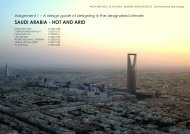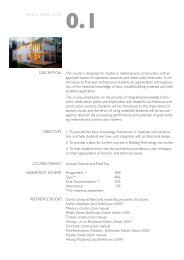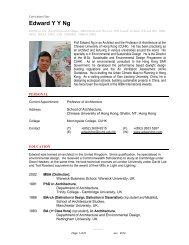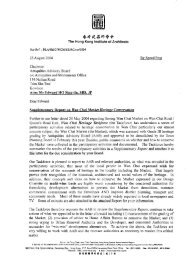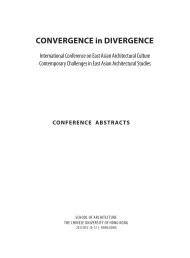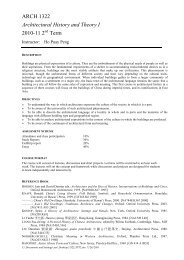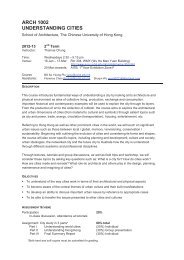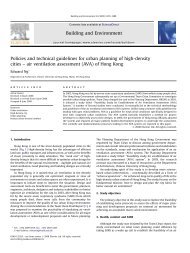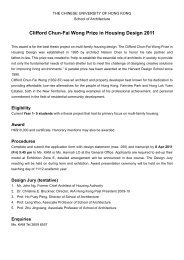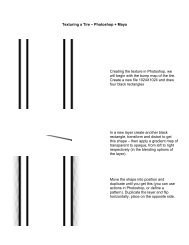Notebook III - School of Architecture - The Chinese University of ...
Notebook III - School of Architecture - The Chinese University of ...
Notebook III - School of Architecture - The Chinese University of ...
You also want an ePaper? Increase the reach of your titles
YUMPU automatically turns print PDFs into web optimized ePapers that Google loves.
ARCHITECTURE<br />
C U H K
ARCHITECTURE · CUHK 2003 – 2004
notebook<br />
<strong>Notebook</strong> <strong>III</strong><br />
2 This is the third working notebook <strong>of</strong> the due general consideration to all. <strong>The</strong> thesis is <strong>of</strong> the studios. It is also conducted in a number<br />
3<br />
architecture programme. It describes the<br />
programme in its present state as it has developed<br />
since its inception in 2001.<br />
During this development the fundamental<br />
structure and ideas have remained much<br />
the same and have continued to provide a<br />
common ground in the department for teaching,<br />
research, and discourse at all levels.<br />
In design, teaching has continued in the four<br />
primary studios: habitation, urbanization, technics,<br />
and tectonics, with participation in all four<br />
from all levels <strong>of</strong> students.<br />
However, the experiences <strong>of</strong> the year have led<br />
to two further developments.<br />
1. Research on the position <strong>of</strong> each studio is<br />
explicitly recognized as the basis for teaching,<br />
leading to greater articulation <strong>of</strong> the historical,<br />
theoretical, and critical foundations <strong>of</strong> the<br />
studio. A series <strong>of</strong> seminars / presentations<br />
based on this research accompanies the<br />
design programme <strong>of</strong> each studio.<br />
2. A greater distinction is made between<br />
the undergraduate and graduate work. <strong>The</strong><br />
graduate student is expected to have fulfilled<br />
the design requirements <strong>of</strong> all four primary<br />
studios and be able to design from a focused<br />
position – <strong>of</strong> any <strong>of</strong> the studios, but with<br />
expected to present an articulate personal<br />
position in design which can be presented<br />
theoretically and practically in terms <strong>of</strong> “primary<br />
positions” such as the four in the undergraduate<br />
programme.<br />
In humanities, the courses more clearly<br />
present the relationship between history,<br />
theory, and criticism. Each course in the<br />
undergraduate programme engages all three<br />
areas, while in the graduate programme elective<br />
courses deal with these in a more specialized<br />
manner.<br />
In technology, the distinction between courses<br />
in construction, structures, and environment<br />
is addressed in the graduate programme in<br />
specialized courses and separate subjects with<br />
their distinct body <strong>of</strong> theory. In the undergraduate<br />
programme, issues in these areas are<br />
presented as aspects <strong>of</strong> one unified subject:<br />
technology. This emphasizes the unity <strong>of</strong> technological<br />
considerations in the real building<br />
while recognizing that advanced study requires<br />
specific theoretical knowledge <strong>of</strong> each one.<br />
Research has gained a clearer position in the<br />
programme as a whole. <strong>The</strong> programme <strong>of</strong><br />
teaching is supported by a parallel programme<br />
<strong>of</strong> research. Both are based on the same ideas<br />
and structure in architecture and education.<br />
<strong>The</strong> research is not only integral to the work<br />
<strong>of</strong> research units. <strong>The</strong>se form a group which<br />
supports the teaching programme particularly<br />
at the graduate level, and conducts funded<br />
research and development.
contents<br />
4 <strong>Architecture</strong> 7<br />
5<br />
<strong>The</strong> house and the city 8<br />
Education 10<br />
<strong>School</strong> 12<br />
Design 14<br />
<strong>The</strong>ory 16<br />
Programme 18<br />
Primary studios 20<br />
Habitation 22<br />
Urbanization 23<br />
Tectonics 24<br />
Technics 25<br />
Places <strong>of</strong> life 26<br />
Teaching 31<br />
Types <strong>of</strong> study 32<br />
Modes <strong>of</strong> study 34<br />
Courses 36<br />
Research 42<br />
Student work 2002 – 2003 45<br />
Rooms 58<br />
Dates 60<br />
Teachers 62
architecture<br />
6 7
house&city<br />
8 <strong>Architecture</strong> is the formal extension <strong>of</strong> the<br />
common human instinct for building shelter in<br />
search <strong>of</strong> safety and permanence. It embodies<br />
both the physical and the metaphysical;<br />
the secular and the sacred. It is the result <strong>of</strong><br />
habitation in all its aspects and scales, and the<br />
expression in built form <strong>of</strong> all human institutions,<br />
from a primal hut to THE HOUSE, the<br />
village, and THE CITY. It is the embodiment <strong>of</strong><br />
human intentions, myths, and traditions, past,<br />
present, and future, all unified in the eternal<br />
presence <strong>of</strong> each work <strong>of</strong> architecture.<br />
9<br />
<strong>The</strong> study <strong>of</strong> architecture is ultimately the study <strong>of</strong><br />
works <strong>of</strong> architecture.<br />
A work <strong>of</strong> architecture is much like an object in<br />
nature. It is unique and universal at the same time,<br />
a complete and internally coherent form, and at the<br />
same time a component <strong>of</strong> a larger form. Its study<br />
requires formalized thought if it is not to be merely a<br />
description <strong>of</strong> the form itself.
education<br />
10 “<strong>The</strong> appreciation <strong>of</strong> the structure <strong>of</strong> ideas is<br />
11<br />
that side <strong>of</strong> a cultured mind which can only grow<br />
under the influence <strong>of</strong> a special study. I mean<br />
are <strong>of</strong> the same order as what anybody else does when … engaged in like activities – if he is to<br />
that eye for the whole chessboard, for the bearing<br />
<strong>of</strong> one set <strong>of</strong> ideas on another. Nothing but<br />
achieve understanding. <strong>The</strong> difference is in degree, not in kind.”<br />
a special study can give any appreciation for<br />
the exact formulation <strong>of</strong> general ideas, for their<br />
Jerome Bruner, <strong>The</strong> process <strong>of</strong> education<br />
relation when formulated, for their service in<br />
the comprehension <strong>of</strong> life. A mind so disciplined<br />
should be both more abstract and more concrete.<br />
It has been trained in the comprehension<br />
<strong>of</strong> abstract thought and in the analysis <strong>of</strong> facts.”<br />
Alfred North Whitehead<br />
<strong>The</strong> aims <strong>of</strong> education<br />
“What a scientist does at his desk or in his laboratory, what a literary critic does in reading a poem,
school<br />
12 In architecture there is little to teach and much<br />
A school is a way <strong>of</strong> thought, a position on<br />
13<br />
to learn.<br />
how the past is seen and the future is formed,<br />
a direction on how the past and the future are<br />
united in action at the present.<br />
<strong>The</strong> school aims to become an increasingly<br />
active participant in the city and to embrace the<br />
city increasingly in its routines <strong>of</strong> teaching and<br />
research. It aims in a sense to be a Hong Kong<br />
school <strong>of</strong> architecture.<br />
It relates to the universal side <strong>of</strong> its discipline<br />
– free from time and place. At the same time<br />
it must relate specifically to its very particular<br />
time and place. It must concern itself with the<br />
universal and the particular, with the whole<br />
and the detail as an entity in itself, and as a<br />
context for cultivation <strong>of</strong> habits <strong>of</strong> mind, both<br />
broad and focused.<br />
A school is a community <strong>of</strong> students <strong>of</strong><br />
distinct intellectual identities sharing in the<br />
common purpose <strong>of</strong> education through<br />
discourse and discovery. <strong>The</strong> school draws<br />
its identity from the common ground <strong>of</strong> this<br />
process.<br />
A school <strong>of</strong> architecture is a civic and cultural<br />
institution as well as a place <strong>of</strong> pr<strong>of</strong>essional<br />
education.<br />
<strong>The</strong> most effective part <strong>of</strong> “teaching” does not<br />
take place in individual courses, but is cultivated<br />
through a culture <strong>of</strong> search, attention<br />
to detail, and patient search for the ways and<br />
nature <strong>of</strong> things.
design<br />
14 Design is widely and validly regarded as the core<br />
Design pedagogy, if it is not be limited to <strong>The</strong>re are no “general” ways <strong>of</strong> seeing,<br />
15<br />
<strong>of</strong> architectural education. However, it is not<br />
demonstration and apprenticeship, must describing, or designing a form, just as there<br />
limited to the work in studios. It applies to all<br />
involve theory, an operational theory which are no “general” ways <strong>of</strong> studying a subject.<br />
studies in the programme. It is a way <strong>of</strong> thinking.<br />
provides the tools for conception, description, Any such action is particular to the terms <strong>of</strong><br />
It is a habit <strong>of</strong> mind towards every action as a<br />
and discussion <strong>of</strong> design. Without a theoretical<br />
its theoretical structure. All “seeing” is particu-<br />
fusion <strong>of</strong> knowledge, reason, and esthetic intention.<br />
structure, a basis <strong>of</strong> reference, the words lar within a culture <strong>of</strong> beliefs, a set <strong>of</strong> implicit<br />
It is an approach to education.<br />
we use have little more than personal and assumption, or an underlying theoretical structure<br />
isolated meaning, limiting every statement to<br />
which exists independently <strong>of</strong> any one<br />
personal opinion, since it cannot exist independently<br />
object being seen. In a sense, speaking <strong>of</strong> the<br />
<strong>of</strong> a person.<br />
process <strong>of</strong> design without reference to posi-<br />
tion is too abstract.<br />
In teaching, the personal passion <strong>of</strong> a teacher<br />
about a viewpoint is important, but is no<br />
replacement for the intellectual independence<br />
afforded by a free-standing theoretical structure<br />
for the subject.<br />
<strong>The</strong> process <strong>of</strong> design, described simply in<br />
terms <strong>of</strong> a cognitive activity, is too abstract to<br />
be useful to a student <strong>of</strong> design. At an abstract<br />
level, free <strong>of</strong> content, the process is the same<br />
in any subject. <strong>The</strong>refore the study <strong>of</strong> design<br />
in a particular subject needs to be particularly<br />
related to the content <strong>of</strong> works in that subject.
Process, product, and language<br />
theory<br />
Studio Courses Research<br />
16 “<strong>The</strong>ory is important as the instrument <strong>of</strong> generalization.<br />
<strong>The</strong> study <strong>of</strong> architecture is ultimately the Studios, like laboratories, are occasions <strong>of</strong> Courses begin with a body <strong>of</strong> theory as a Research is <strong>of</strong> course the very process<br />
17<br />
But in so far as it involves the descrip-<br />
study <strong>of</strong> works <strong>of</strong> architecture. Such a study direct observation, formulation <strong>of</strong> thought, subject in a particular area such as history or involved in both studios and courses. Research<br />
tion <strong>of</strong> a picture in a non-pictorial language it<br />
requires two conditions:<br />
discovery, and design. This process affords structures.<br />
studies are intended to provide experience<br />
causes loss <strong>of</strong> something (analogy with exchange<br />
increasing skill in working with a sense <strong>of</strong><br />
<strong>of</strong> working with teachers on actual research<br />
<strong>of</strong> energy). It is important but costly. So we<br />
1. It requires formalized thought if it is not to intention and strategy combined with mental <strong>The</strong>y are theoretical constructs <strong>of</strong> a process projects.<br />
should use it where necessary and take advantage<br />
be limited merely to a description <strong>of</strong> each agility in seeing alternative possibilities in arriv-<br />
<strong>of</strong> sustained and rigorous observation and<br />
<strong>of</strong> direct use <strong>of</strong> ‘pictures’ wherever possible.<br />
work in isolation.<br />
ing at conclusions: design.<br />
should not be regarded as absolute informa-<br />
This affords great economy besides guarding<br />
tion. <strong>The</strong> important point about the courses is<br />
against analytical fallacy in design. It safeguards<br />
2. It must be rooted in the works <strong>of</strong> architecture,<br />
not only the information they contain but the<br />
‘intuition,’ i.e. the thing ‘tout ensemble.’”<br />
the processes related to their creation.<br />
process through which they arrive at a theo-<br />
retical construct and its application.<br />
Werner Heisenberg<br />
<strong>The</strong>ory, as formalized thought, is an integral<br />
part <strong>of</strong> all studies in the programme. In studios<br />
it guides the process <strong>of</strong> design and helps to<br />
articulate what is <strong>of</strong>ten experienced as “intuitive”<br />
action. In courses it is the direct object <strong>of</strong><br />
study. In research it is the point <strong>of</strong> departure<br />
for definition <strong>of</strong> the issue under research and<br />
the research method. In all cases, the teaching<br />
approach aims to <strong>of</strong>fer the student the<br />
opportunity to appreciate the structure <strong>of</strong><br />
thought and “arrive” at the theory rather than<br />
simply receive it as absolute dogma, or pure<br />
information.
Design: theory – practice – process<br />
programme<br />
18 “Students … have a limited exposure to the<br />
<strong>The</strong> programme deals with one subject:<br />
19<br />
materials they are to learn. How can this exposure<br />
architecture.<br />
be made to count in their thinking for the<br />
rest <strong>of</strong> their lives? <strong>The</strong> dominant view among<br />
<strong>The</strong> programme is not merely a collection <strong>of</strong><br />
men who have been engaged in preparing and<br />
courses for covering information. It is itself a<br />
teaching new curricula is that the answer to this<br />
shaper <strong>of</strong> ideas about the subject. It is also a<br />
question lies in giving students an understanding<br />
structure allowing the study <strong>of</strong> architecture at<br />
<strong>of</strong> the fundamental structure <strong>of</strong> whatever subjects<br />
different levels <strong>of</strong> complexity and articulation,<br />
we choose to teach.”<br />
as a unified whole, or in different degrees <strong>of</strong><br />
detail and different aspects.<br />
Jerome Bruner<br />
<strong>The</strong> process <strong>of</strong> education<br />
<strong>The</strong> structure is essentially a theoretical construct,<br />
a “theory” relating form to our observations<br />
about it, relating our observations to<br />
our actions, relating our designs to our observations.<br />
At present much <strong>of</strong> this connecting<br />
thought is unstated or unarticulated. It appears<br />
as opinion and anecdote and is not explicitly<br />
stated in such a way that it can be refined<br />
with experience, can act as a repository <strong>of</strong><br />
accumulated experience in the form <strong>of</strong> knowledge.<br />
In a way, the studios and their conduct<br />
afford the beginning <strong>of</strong> such a process.<br />
It consists <strong>of</strong> two main parts: courses and<br />
studios. In general studios focus on DESIGN; the<br />
courses deal with THEORETICAL MATERIAL.<br />
Pr<strong>of</strong>essional programme<br />
Postgraduate programmes<br />
BSSc(AS)<br />
Architectural studies<br />
MArch<br />
<strong>Architecture</strong><br />
PGDip<br />
Sustainable and environmental design<br />
MSc<br />
Sustainable and environmental design<br />
MPhil<br />
PhD
Primary studios<br />
studio<br />
20 Studios are occasions for the exploration <strong>of</strong><br />
Design, a process <strong>of</strong> resolution <strong>of</strong> complex<br />
factors and intentions, begins with a conception<br />
<strong>of</strong> form, evolves in stages <strong>of</strong> development,<br />
and ends as a form.<br />
Any design, in fact, involves all four aspects,<br />
21<br />
ideas and the development <strong>of</strong> skills in their<br />
application through design. <strong>The</strong>y reflect several<br />
positions in the school on education, process <strong>of</strong><br />
design, and relationship <strong>of</strong> theory to practice in<br />
design.<br />
<strong>The</strong>y are based on themes or positions in architectural<br />
design, not building types. Students from<br />
all levels are engaged in each one <strong>of</strong> them; they<br />
are not separated according to years. <strong>The</strong>y are<br />
not merely places <strong>of</strong> instruction. <strong>The</strong> studios are<br />
occasions for study and research by teachers<br />
and students and form the core and culture <strong>of</strong><br />
the school.<br />
It operates within a domain – the house and<br />
the city – with its particular basic concepts,<br />
structures, and vocabularies.<br />
Design proceeds from a designer’s sense <strong>of</strong><br />
direction or position. Four such positions are<br />
the basis <strong>of</strong> the primary design studios:<br />
Habitation<br />
Urbanization<br />
Tectonics<br />
Technics<br />
but usually with one as the leading aspect.<br />
<strong>The</strong> four positions are studied explicitly in<br />
the undergraduate programme and provide<br />
the prerequisite for the graduate programme<br />
in design. At the graduate level students are<br />
expected to develop their own sense and<br />
skills in terms <strong>of</strong> the primary positions.<br />
Studios include students from all levels from<br />
first to the final years. All years work on similar<br />
projects but at different levels <strong>of</strong> complexity.<br />
In a sense, the projects studied at different<br />
years form a nested set <strong>of</strong> projects, beginning<br />
at the simplest possible level and increasing in<br />
complexity at each year.
habitation<br />
22 “Today, … our architecture has<br />
passed from the cave to the<br />
garden, from the monument to<br />
the dwelling house. But in throwing<br />
open our buildings to the daylight<br />
and the outdoors, we will forget, at<br />
our peril, the co-ordinate need for<br />
quiet, for darkness, for inner privacy,<br />
for retreat. <strong>The</strong> cloister in both<br />
its public and private form is a<br />
constant element in the life <strong>of</strong> men<br />
in cities. Without formal opportunities<br />
for isolation and contemplation,<br />
opportunities that require enclosed<br />
space free from prying eyes and<br />
extraneous stimuli and secular<br />
interruptions, even the most externalised<br />
and extroverted life must<br />
eventually suffer. <strong>The</strong> home without<br />
such cells is but a barracks: the<br />
city that does not possess them is<br />
but a camp. In the medieval city<br />
the spirit had organised shelters<br />
and accepted forms <strong>of</strong> escape<br />
from worldly importunity. Today,<br />
the degradation <strong>of</strong> the inner life<br />
is symbolised by the fact that the<br />
only place sacred from interruption<br />
is the private toilet.”<br />
Habitation begins as the routines <strong>of</strong> life take<br />
place and develop significant form. <strong>The</strong> form<br />
becomes significant as its ambiance, its conditions<br />
<strong>of</strong> light, its geometry, its relationship to<br />
other forms embody symbolic significance. It is<br />
not merely a response to immediate functions<br />
but also the embodiment <strong>of</strong> myths, customs,<br />
and beliefs. <strong>The</strong> distance between two persons<br />
in conversation, the seating arrangement<br />
around a room or a table, the place <strong>of</strong> entry<br />
into a room, the shape <strong>of</strong> gathering around<br />
an event, a procession. <strong>The</strong>se are captured in<br />
art, folklore, literature, and customs in various<br />
cultures, and have given timeless significance<br />
to art, literature, and architecture. <strong>The</strong>y enable<br />
a work <strong>of</strong> architecture to capture the entire<br />
history and culture <strong>of</strong> a community – the past,<br />
present, and future – in a single act.<br />
“Every great event has its geographical<br />
epicenter – that <strong>of</strong> the<br />
American Revolution was the few<br />
city blocks around Carpenters’ and<br />
Independence Halls in Philadelphia;<br />
that <strong>of</strong> the great French Revolution<br />
was the Place de la Bastille; that<br />
<strong>of</strong> the Revolution <strong>of</strong> 1848 was the<br />
Luxembourg Gardens.”<br />
John Kenneth Galbraith<br />
<strong>The</strong> age <strong>of</strong> uncertainty<br />
<strong>The</strong> studio studies the shaping influence<br />
<strong>of</strong> factors beyond the individual building.<br />
Although architecture may seem traditionally<br />
to have been concerned with individual<br />
monuments – the ground cover which makes<br />
the fabric <strong>of</strong> the city – the relationships, traditions,<br />
and common needs that shape the<br />
ground cover influence the city as a whole<br />
and provide a formal context for the design<br />
<strong>of</strong> each part. <strong>The</strong> context in turn evolves with<br />
the building <strong>of</strong> each building. It in a way one<br />
is designing the city with the design <strong>of</strong> each<br />
building. Each building is a variation <strong>of</strong> the<br />
timeless architectural duality <strong>of</strong> “the city and<br />
the house.”<br />
23<br />
Lewis Mumford<br />
Culture <strong>of</strong> cities<br />
Routines <strong>of</strong> life<br />
urbanization<br />
Land form and urban fabric
tectonics<br />
technics<br />
Jun’ichiro Tanizaki<br />
In praise <strong>of</strong> shadows<br />
Material composition<br />
<strong>The</strong> curvature in the entablature <strong>of</strong> the Parthenon,<br />
the joints between stones at Machu<br />
Picchu, the composition <strong>of</strong> windows in the<br />
chapel at Ronchamp, are beyond functional<br />
necessity.<br />
24 “Paper, I understand, was invented Tectonics is a manifestation in architecture<br />
“One <strong>of</strong> the most obvious prob-<br />
<strong>The</strong> studio studies and practices the innova-<br />
25<br />
by the <strong>Chinese</strong>, but Western paper <strong>of</strong> the esthetic imperative as part <strong>of</strong> human<br />
tive processes and skills to design buildings,<br />
is to us no more than something nature. It attends to the potential <strong>of</strong> building<br />
one might say from first principles, based on<br />
to be used, while the texture <strong>of</strong><br />
for qualities inherent in the material,<br />
specific technologies or needs.<br />
<strong>Chinese</strong> paper and Japanese<br />
economy in their use, potential for elegance in<br />
paper gives us a certain feeling<br />
resolution in their juxtaposition, and the total<br />
<strong>Architecture</strong> owes much to buildings and<br />
<strong>of</strong> warmth, <strong>of</strong> calm and repose.<br />
compositional quality <strong>of</strong> form. It goes beyond<br />
works designed outside the architectural<br />
Even the same white could as well necessity and responds to a sensibility <strong>of</strong> a<br />
tradition. New needs, new technologies, or<br />
be one color for Western paper<br />
higher order as mastery and skill.<br />
new environments all have led to examples<br />
and another for our own. Western<br />
such as the Crystal Palace, the 19 th -century<br />
paper turns away the light, while It relates to the sensibility that has characterized<br />
railway arches, the viaducts and bridges. <strong>The</strong>y<br />
our paper seems to take it in,<br />
all fine works <strong>of</strong> architecture. It has been<br />
best illustrate the point <strong>of</strong> exploration in the<br />
to envelop it gently, like the s<strong>of</strong>t<br />
the quality <strong>of</strong> all work <strong>of</strong> architecture.<br />
technics studio.<br />
surface <strong>of</strong> a first snowfall. It gives<br />
<strong>of</strong>f no sound when is crumpled or<br />
folded, it is quiet and pliant to the<br />
touch as the leaf <strong>of</strong> a tree. ”<br />
lems in building the dome <strong>of</strong><br />
Santa Maria del Fiore was how to<br />
transport heavy building materials<br />
such as sandstone beams and<br />
slabs <strong>of</strong> marble several hundred<br />
feet above the ground and then<br />
place them into position with<br />
the accuracy demanded by Filippo’s<br />
design. <strong>The</strong> sandstone beam<br />
weighed some 1,700 pounds each,<br />
and hundreds <strong>of</strong> them needed<br />
to be raised on to the cupola.<br />
To solve this problem Filippo<br />
was compelled to imagine ‘some<br />
unheard-<strong>of</strong> machine’ to move<br />
and carry tremendous weights to<br />
incredible heights. <strong>The</strong> hoist that he<br />
created was to become one <strong>of</strong> the<br />
most celebrated machines <strong>of</strong> the<br />
Renaissance, a device that would<br />
be studied and sketched by numerous<br />
other architects and engineers,<br />
including Leonardo da Vinci.”<br />
Ross King<br />
Brunelleschi’s dome<br />
Materials and means<br />
<strong>The</strong> bold and innovative approach to their<br />
design is no doubt an integral part <strong>of</strong> any<br />
work. But the power <strong>of</strong> such works is evident<br />
in the ready place they find in many derivative<br />
designs that seem to follow from them.
Places <strong>of</strong> life<br />
places<br />
26 “A building is a world within a world. Buildings<br />
<strong>The</strong> infinite number <strong>of</strong> different buildings<br />
All places <strong>of</strong> habitation are places for living.<br />
27<br />
personify places <strong>of</strong> worship, or <strong>of</strong> home, or other<br />
and the complexity <strong>of</strong> their functions <strong>of</strong>ten<br />
And a place <strong>of</strong> living must at a basic level<br />
institutions <strong>of</strong> man.”<br />
obscure the fundamental unity <strong>of</strong> origin and<br />
provide for all essential routines <strong>of</strong> habitation.<br />
simplicity <strong>of</strong> purpose from which they evolve<br />
<strong>The</strong>se can be seen in terms <strong>of</strong> three modes<br />
Louis I Kahn<br />
in the course <strong>of</strong> history. In a sense every<br />
<strong>of</strong> daily life: gathering, work, and solitude. <strong>The</strong>y<br />
design is a re-enactment <strong>of</strong> that process.<br />
are the necessary constituent parts <strong>of</strong> a dwelling<br />
<strong>of</strong> any size, whether a one-room apartment<br />
Buildings and the functions or institutions they<br />
or an expansive house. <strong>The</strong> study and<br />
<strong>Architecture</strong>: the shed and the cathedral? <strong>The</strong>re<br />
serve, though infinite in number and boundless<br />
design <strong>of</strong> places <strong>of</strong> living involves the entire<br />
is shed in every cathedral, a cathedral in every<br />
in time and place, can be seen in terms<br />
scope <strong>of</strong> architecture at the most fundamental<br />
shed. (Apologies to Nikolaus Pevsner)<br />
<strong>of</strong> the evolution or permutations rooted in a<br />
level. It touches on narrowly defined functions<br />
and embodies timeless and far-reaching<br />
In the face <strong>of</strong> the infinite variety <strong>of</strong> particular limited number <strong>of</strong> primary human activities<br />
situations it seems necessary to seek a deep and forms where they take place: Live<br />
customs and beliefs. <strong>The</strong> house is perhaps<br />
structure in terms <strong>of</strong> which to understand and<br />
the most symbolically significant <strong>of</strong> any form<br />
act on them. At the same time, it is necessary<br />
Work<br />
in architecture. It is the seminal idea in architecture,<br />
as the family might be regarded as<br />
to recognize the unique quality <strong>of</strong> every work.<br />
Design becomes a fusion <strong>of</strong> the universal and<br />
Learn<br />
the seminal unit <strong>of</strong> human society. <strong>The</strong> hearth,<br />
the particular.<br />
the altar, the window, the doorway are in the<br />
Worship<br />
house, more distinctly than in any other work<br />
In terms <strong>of</strong> physical form, architecture exists<br />
<strong>of</strong> architecture, routines <strong>of</strong> life.<br />
within a domain defined by two significant<br />
Perform<br />
forms: the house and the city. In several senses<br />
this is the context <strong>of</strong> every work <strong>of</strong> architecture.<br />
Travel<br />
Each work, while unique to its time and<br />
place, is also a variation between these two<br />
Exchange<br />
poles: in a sense every form is a house, and is<br />
a city.<br />
A house comprises three fundamental places:<br />
a place <strong>of</strong> work, a place <strong>of</strong> gathering, and a<br />
place <strong>of</strong> solitude. And so do all forms evolving<br />
from it.<br />
Live
Work<br />
Learn<br />
Worship<br />
Perform<br />
Travel<br />
Exchange<br />
28 Much <strong>of</strong> human life is spent in working. Much Learning as one <strong>of</strong> the main human activities Worship is a fundamental aspect <strong>of</strong> human Performance is an integral part <strong>of</strong> human Movement – physically moving from one place Exchange is the predominant mode <strong>of</strong><br />
29<br />
<strong>of</strong> human thought is preoccupied with work. has been the focus <strong>of</strong> a major part <strong>of</strong> human life. <strong>The</strong> places <strong>of</strong> worship, when not limited gathering, communication, and social action. to another – is an abstract human activity social contact in the human community.<br />
Much <strong>of</strong> human history is the record <strong>of</strong> working<br />
civilization, has led to the development <strong>of</strong> a to the individual, have had much in common Seen this way, a place <strong>of</strong> performance is a pervasive through many functions. Often it <strong>The</strong> market place and the basilica share<br />
conditions. Much <strong>of</strong> architecture deals with distinct line <strong>of</strong> social institutions, and has occu-<br />
to other places <strong>of</strong> gathering and performance. place <strong>of</strong> gathering with more or less specific is difficult to distinguish from the content <strong>of</strong> much in the early social activities and<br />
places <strong>of</strong> work. Projects for places for working<br />
pied a distinct section <strong>of</strong> architectural history. Despite many forms and doctrines, the archi-<br />
requirements. But, like social activity, the form movement and it seems to be the life force <strong>of</strong> endure to our time in the shape <strong>of</strong> many<br />
serve two aims. In one way, they serve as Despite the extensive development <strong>of</strong> their tecture <strong>of</strong> worship in all cultures has several <strong>of</strong> the place and <strong>of</strong> the building giving place public places relating in an intricate way with public places. <strong>The</strong> hawkers, the street<br />
occasions for the study <strong>of</strong> this major aspect <strong>of</strong> many forms, the place <strong>of</strong> the individual student common underlying characteristics, even to the performance seems to come as much the particular function they seem to perform, vendors, the shopkeepers, and the shopping<br />
human life: its history, its influence in human remains central to all such institutions. while it responds to important symbolic and from the gathering and its symbolic implications<br />
such as places <strong>of</strong> arrival and departure, and<br />
centers have long been the hub <strong>of</strong><br />
attitudes, its impact on other aspects <strong>of</strong> culture,<br />
doctrinal differences. <strong>The</strong> history <strong>of</strong> the archi-<br />
as from its functional requirements. It promenades.<br />
social activity and represent more than the<br />
etc. In another way they serve to bring<br />
tecture <strong>of</strong> worship responds also to ceremony is expected that the design <strong>of</strong> places <strong>of</strong> per-<br />
material they <strong>of</strong>fer for sale. In subtle ways<br />
all such study into focus as occasions for the<br />
and ritual. In some way it celebrates universal formance would <strong>of</strong>fer an occasion for studies<br />
they act as training posts, as playgrounds,<br />
study and practice <strong>of</strong> design.<br />
existence by placing the human being in the at a fundamental level <strong>of</strong> performance as a<br />
as places <strong>of</strong> social gathering, and as various<br />
presence <strong>of</strong> timeless and constant natural elements:<br />
part <strong>of</strong> human civilizing act as well as an exer-<br />
parts <strong>of</strong> a collective forum accommodating<br />
light, earth, water, and air. Yet the essencise<br />
in design with functional requirements.<br />
and embodying urban life. <strong>The</strong>y accommo-<br />
tial condition <strong>of</strong> worship remains solitude.<br />
date a way <strong>of</strong> conducting public life.
teaching<br />
30 31
studymode<br />
Year 1: foundation Years 2, 3, and 4 Year 5: thesis Independent studies<br />
32 Design teaching, research, and practice are inseparable.<br />
To learn to see what exists is the key to creative<br />
Architectural design – research, study, and <strong>The</strong> culmination <strong>of</strong> the programme is an A student enrolled at the department may<br />
33<br />
<strong>The</strong>y are conducted in four primary studios, each focused<br />
engagement in the study and design <strong>of</strong> practice – is studied in four studios, each<br />
on one position or theme.<br />
architecture.<br />
focused on one <strong>of</strong> four themes.<br />
<strong>The</strong> first year deals with the fundamental<br />
structure <strong>of</strong> the programme, its concepts and<br />
requisite methods and skills. It provides the<br />
ground for more advanced, more focused<br />
studies.<br />
<strong>The</strong> work <strong>of</strong> the year consists <strong>of</strong> studies <strong>of</strong><br />
existing communities and basic concepts in<br />
architecture. <strong>The</strong>se studies are informed by<br />
three courses <strong>of</strong> lectures: architectural theory<br />
and history, technology, and communication.<br />
<strong>The</strong>se courses are closely related to the work<br />
in the studio while growing more independent<br />
and specialized as they advance.<br />
Each studio comprises students from all three<br />
levels, although the groups are organized in<br />
different ways according to the approach in<br />
the studio. <strong>The</strong> internal organization <strong>of</strong> the<br />
studios varies in response to the particular<br />
circumstances <strong>of</strong> each studio.<br />
extended period <strong>of</strong> self-directed study giving<br />
the student the opportunity for focused<br />
reflection, consolidation <strong>of</strong> various studies<br />
in earlier years, and expression <strong>of</strong> his or her<br />
position through investigation <strong>of</strong> selected<br />
architectural issues through research and<br />
design: the thesis.<br />
In a sense, the thesis is a collective manifestation<br />
<strong>of</strong> the work <strong>of</strong> the school. It provides the<br />
grounds for examination <strong>of</strong> the programme<br />
and informs discussion about all levels and<br />
aspects.<br />
carry out studies, based on an approved proposal,<br />
independently or in any other institution.<br />
This applies to students who may take part<br />
in exchanges or carry out special studies and<br />
field research.<br />
A year out <strong>of</strong> the formal studies in the school<br />
separates the undergraduate from the graduate<br />
part <strong>of</strong> the programme.<br />
This year is intended as a period <strong>of</strong> practical<br />
experience or other forms <strong>of</strong> essentially independent<br />
studies.<br />
<strong>The</strong> experience in practice seems to help synthesize<br />
the studies up to this point and ground<br />
them in more direct understanding through<br />
practical application.<br />
It is possible for students also to spend all or<br />
any part <strong>of</strong> this year in individually proposed<br />
studies or work based on research, working<br />
with community groups in developing countries,<br />
or other architecturally related activities.
Design: product, form, and content<br />
studytype<br />
Studio project<br />
<strong>School</strong> project<br />
34 Design is not merely problem-solving. <strong>The</strong> scope<br />
Studio projects are occasions for study and<br />
<strong>School</strong> projects are formulated independently<br />
35<br />
exercise based on the studio as “positions,”<br />
not as dogma.<br />
<strong>of</strong> a solution to a problem is confined to its<br />
description. Design is an act <strong>of</strong> creating a new<br />
and concrete “fact.” It is related to needs, limits,<br />
potentials, and intentions. But it is not reducible<br />
to any such abstraction or produceable in direct<br />
response to them.<br />
<strong>The</strong> scope <strong>of</strong> the projects varies to suit the<br />
particular approach and pedagogical strategy<br />
<strong>of</strong> the studio. <strong>The</strong>y provide the possibility<br />
<strong>of</strong> exercises which are particularly suited to<br />
the issues in the studio. Beyond the daily and<br />
immediate educational objectives, the studies<br />
and their results make a cumulative contribution<br />
to an implicit discourse between different<br />
positions in architecture.<br />
However, in all studios the exercises remain<br />
as design exercises within the scope <strong>of</strong> architecture.<br />
<strong>of</strong> the studio positions and are occasions for<br />
the application <strong>of</strong> particular design positions<br />
to general designs. As in other parts <strong>of</strong> the<br />
programme they are not only statements <strong>of</strong><br />
“design projects,” but are themselves a way <strong>of</strong><br />
seeing and interpreting building types.<br />
At the simplest level, three kinds <strong>of</strong> places<br />
seem to define the human world: place <strong>of</strong><br />
work, place <strong>of</strong> gathering, and place <strong>of</strong> solitude.<br />
<strong>The</strong>y are the necessary elements <strong>of</strong> any<br />
complete human environment: the house, the<br />
school, the factory, the temple.
Design: language <strong>of</strong> discourse<br />
It appears that we use the common language. In<br />
fact, we adopt the common language in developing<br />
a special one the terms <strong>of</strong> which embody<br />
specialized meaning and knowledge <strong>of</strong> architecture<br />
and can serve for advancement <strong>of</strong> architecture<br />
through its refinement. What are the terms<br />
<strong>of</strong> this specialized language?<br />
courses<br />
36 In what terms do we discuss design and works<br />
<strong>The</strong> courses are studied at three levels in each <strong>The</strong> minimum number <strong>of</strong> courses possible A selection <strong>of</strong> courses as further development A series <strong>of</strong> research-based electives <strong>of</strong>fered by<br />
37<br />
<strong>of</strong> architecture?<br />
<strong>of</strong> the following four areas:<br />
<strong>of</strong> the mandatory courses. <strong>The</strong>re is no linear every member <strong>of</strong> the faculty.<br />
or chronological order between the mandatories<br />
and the electives.<br />
Design<br />
Humanities<br />
Technology<br />
Pr<strong>of</strong>essional practice<br />
<strong>The</strong> three levels are:<br />
Mandatory courses Elective courses Research studies<br />
dealing with fundamentals, principles, and<br />
premises underlying the area <strong>of</strong> those<br />
courses. <strong>The</strong>se apply to humanities as well as<br />
technology.<br />
<strong>The</strong> studies draw continuity from the first<br />
level – fundamentals – depth from the second,<br />
and vitality from the third. All three levels<br />
inform one another and evolve within the balanced<br />
form <strong>of</strong> the programme.
design<br />
humanities<br />
38 “In the immediate world, everything<br />
is to be discerned, for him<br />
forms, exists through tradition.”<br />
REQUIRED<br />
“<strong>The</strong> whole cultural world, in all its<br />
REQUIRED<br />
39<br />
who can discern it, and centrally<br />
Design studios<br />
Introduction to architecture<br />
and simply, without either dissection<br />
into science, or digestion into Graphics and visual studies<br />
Edmund Husserl<br />
Architectural history and theory<br />
art, but with the whole <strong>of</strong> consciousness,<br />
seeking to perceive it as Computer-aided architectural design<br />
I General survey<br />
II Postrenaissance<br />
it stands.”<br />
“All history is modern history.”<br />
<strong>III</strong> Modern and contemporary<br />
James Agee, Walker Evans<br />
Let us now praise famous men<br />
ELECTIVE<br />
Studies in selected topics<br />
Visual design<br />
Digital design media<br />
Research studies<br />
Wallace Stevens<br />
Land and city<br />
Urban design and planning<br />
Architectural theory and criticism<br />
ELECTIVE<br />
Studies in selected topics<br />
Issues in architectural theory and<br />
design<br />
Periods or works <strong>of</strong> architecture<br />
Aspects <strong>of</strong> Asian architecture<br />
Research studies
technology<br />
Advanced building services<br />
ELECTIVE<br />
Studies in selected dopics<br />
Structural design and building structures<br />
Materials and methods <strong>of</strong> construction<br />
Environmental systems and design<br />
Building performance simulation<br />
Research studies<br />
practice<br />
40 “<strong>The</strong> aim <strong>of</strong> the architect is … to REQUIRED<br />
“In ancient Greece the term<br />
REQUIRED<br />
41<br />
infuse into his works something <strong>of</strong><br />
this order and method which is to Introduction to building technology<br />
Pr<strong>of</strong>essional practice<br />
found in nature. Ancient architects<br />
rightly maintained that nature, the Building technology<br />
Pr<strong>of</strong>essional practice and management<br />
greatest <strong>of</strong> all artists in the invention<br />
I Materials and construction<br />
<strong>of</strong> forms, was always their<br />
II Building structure<br />
model. <strong>The</strong>refore, they collected<br />
<strong>III</strong> Environmental technology<br />
the laws according to which she<br />
works in her production as far as Building systems integration<br />
humanly possible … the principle:<br />
such qualities as harmony, proportion,<br />
Advanced construction<br />
symmetry.”<br />
Leon Battista Alberti<br />
Ten books on architecture<br />
architekton originally meant a<br />
‘master carpenter’; building arisans,<br />
shipwrights, and temple designers,<br />
all <strong>of</strong> whom worked in wood, were<br />
architects. Certain Greek artists<br />
also became known as architects<br />
– for example, <strong>The</strong>odoros <strong>of</strong><br />
Samos, renowned as a sculptor,<br />
metalsmith, and architect in the<br />
sixth century B.C. Roman architects,<br />
too, came from a variety <strong>of</strong><br />
backgrounds: private training and<br />
apprenticeship; military engineering;<br />
and the civil service. Although<br />
the Emperor Hadrian dabbled<br />
in architecture, it was not really,<br />
Cicero has written, an appropriate<br />
calling for Roman aristocrats.<br />
Former slaves, released from imperial<br />
service, became architects. Yet<br />
Vitruvius, a self-made man with<br />
experience in military engineering,<br />
tried to dignify architecture,<br />
describing it as a learned career<br />
in his treatise. <strong>The</strong> architect alone,<br />
he wrote, combined firmness and<br />
utility with beauty.”<br />
Mary N. Wods<br />
From craft to pr<strong>of</strong>ession<br />
ELECTIVE<br />
Studies in selected topics <strong>of</strong> pr<strong>of</strong>essional<br />
practice<br />
Research studies
Research, teaching, and learning<br />
research<br />
Architectural projects unit<br />
Architectural history unit<br />
Computation and simulation unit<br />
Community participation unit<br />
42 “Education is not about information.”<br />
<strong>The</strong> unit is a design <strong>of</strong>fice working on projects Members <strong>of</strong> the unit are engaged in a computational<br />
<strong>The</strong> unit works on selected community<br />
43<br />
Alfred North Whitehead<br />
in architecture, interior architecture, landscape<br />
study <strong>of</strong> the Yingzao fashi (Song projects not only with pr<strong>of</strong>essionals from<br />
architecture, urban design, and strategic planning.<br />
dynasty building manual); the architecture and other disciplines, such as social workers and<br />
Research, teaching, and learning are in action<br />
Its mission is to do design and research urban development <strong>of</strong> 19th–20th century educators, but also with community rep-<br />
inseparable. Everyone’s work in the department<br />
<strong>of</strong> the highest pr<strong>of</strong>essional and theoretical China, in particular the foreign architects resentatives and end users. <strong>The</strong>se last two<br />
comprises all three – to varying degrees. More<br />
standard and to contribute to intellectual working in China; the urban development <strong>of</strong> groups provide feedback on the planning and<br />
particularly, no one’s work is purely “teaching,”<br />
activity within and beyond architecture. Major Song dynasty towns and cities; the Pearl River design <strong>of</strong> the projects and, by participating in<br />
if that excludes the process <strong>of</strong> critical examination<br />
projects include master plans for the <strong>Chinese</strong> Delta’s architectural and urban histories; Hong shaping the outcomes, learn about the proc-<br />
and discovery – research – and if it implies<br />
<strong>University</strong> <strong>of</strong> Hong Kong and Shantou Uni-<br />
Kong’s architectural history; <strong>Chinese</strong> vernacuess.<br />
Projects so far include design guidelines<br />
passing <strong>of</strong> information.<br />
versity, regional studies for the Kowloon and lar architecture and villages; Tibetan temples, for school buildings and, post-occupancy<br />
Canton Railway Corporation, and a private houses, and cities; and <strong>Chinese</strong> religious architecture.<br />
evaluation <strong>of</strong> elderly housing.<br />
<strong>The</strong> programme <strong>of</strong> the department serves as<br />
house in Huangshan, China.<br />
the basis for teaching as well as research, and<br />
provides a sub-structure for mutual support<br />
between the two. <strong>The</strong> following funded research<br />
projects operate collectively as a research centre<br />
and individually as research units.<br />
Members <strong>of</strong> the unit work on both the<br />
theoretical and the applied aspects <strong>of</strong> design<br />
computation. On the theoretical side, they<br />
work on shape grammar and its uses in design<br />
process and historical analysis. Towards the<br />
applied end, they work on computational fluid<br />
dynamics, urban visual sustainability, daylighting,<br />
and urban noise.<br />
Environmental and sustainable design unit<br />
<strong>The</strong> unit investigates environmental and sustainable<br />
design <strong>of</strong> buildings and urban spaces,<br />
focusing on Hong Kong’s issues <strong>of</strong> high-density<br />
tropical living. Research findings are formulated<br />
into design tools and good practice<br />
guidelines for the benefit <strong>of</strong> pr<strong>of</strong>essionals.<br />
It promotes environmental and sustainable<br />
design awareness in Hong Kong and mainland<br />
China through education and activities.
work<br />
44 Here is a sample <strong>of</strong> the design work in the<br />
course <strong>of</strong> the year 2002-2003. It is intended<br />
to provide neither a comprehensive document<br />
on the work nor a precise illustration <strong>of</strong> the<br />
programme. But it is clearly related to the programme.<br />
It is presented here with no implicit<br />
intention <strong>of</strong> suggesting a strict linear relationship<br />
between the theory and the practice in the<br />
studios. <strong>The</strong> relationship between the word and<br />
the work is subtle in all instances. It <strong>of</strong>fers rich<br />
ground for further refinement <strong>of</strong> both as they<br />
develop in a reciprocal manner.<br />
45
foundation<br />
<strong>The</strong> house is the seminal form in architecture. It<br />
is the significant form in terms <strong>of</strong> whose transformations<br />
and evolution all other forms can be<br />
understood. Historically it has been to architecture<br />
as the family to society.<br />
46 Year 1<br />
47
habitation<br />
People – <strong>The</strong> expression <strong>of</strong> the human spirit<br />
revealed through the study <strong>of</strong> the human body,<br />
its surface, and its resonance in space. How<br />
people activate architecture, from the collective<br />
to the private action or event.<br />
Place – What is the spirit <strong>of</strong> the place? Its cultural<br />
implication <strong>of</strong> design within specific territories<br />
<strong>of</strong> human habitation.<br />
48 Years 2·3·4<br />
49
Years 2·3·4<br />
urbanization<br />
In a sense the entire history <strong>of</strong> architecture is a<br />
story <strong>of</strong> urbanization, from the early adaptation<br />
<strong>of</strong> caves to the modification <strong>of</strong> land in search<br />
<strong>of</strong> shelter and the creation <strong>of</strong> entirely artificial<br />
worlds.<br />
50 51
Years 2·3·4<br />
tectonics<br />
What is the relationship between space, surface,<br />
and mass? How is the material arranged in a<br />
building? Can we distinguish elements, components,<br />
and systems? What is the mutual influence<br />
between structure, material, and space?<br />
Can we differentiate structural and spatial types,<br />
and are they related? How can space be formed,<br />
structured, and defined? How does the built<br />
order express a conceived order?<br />
52 53
Years 2·3·4<br />
technics<br />
Technics has been defined as “the doctrine <strong>of</strong><br />
arts in general; such branches <strong>of</strong> learning as<br />
respect the arts”; “the method <strong>of</strong> performance<br />
in any art; technical skill; artistic execution”;<br />
“technical terms or objects; things pertaining to<br />
the practice <strong>of</strong> an art or science”; “the theory,<br />
principles, or study <strong>of</strong> an art or a process”; and<br />
“the science or study <strong>of</strong> the mechanical and<br />
industrial arts.”<br />
54 55
thesis<br />
Year 5<br />
Transformable space<br />
<strong>The</strong> thesis marks the intersection between two important states in<br />
students’s work and, in a way, in his or her pr<strong>of</strong>essional life. It begins as<br />
a synthesis <strong>of</strong> previous studies, a sum total <strong>of</strong> many questions unanswered,<br />
much information assimilated and much more set aside, skills<br />
gained and ideas received and developed. As its completion it represents<br />
a fact in its own right embodying ideas, interests, aspirations, and<br />
the student’s sense <strong>of</strong> direction. It marks a new beginning for the cycle<br />
<strong>of</strong> search beyond the formal studies in the school, with much broader<br />
scope and much greater freedom.<br />
56 57
A school <strong>of</strong> architecture<br />
rooms<br />
Design technology lab<br />
58 A school <strong>of</strong> architecture is not a building; it is a<br />
59<br />
school <strong>of</strong> thought. <strong>The</strong> school building is like a village<br />
<strong>of</strong> rooms and routes, all leading to a central<br />
Information technology lab<br />
public place: the market place, the agora, the<br />
exhibition room. It provides places for gathering,<br />
work, and play; public display and solitary reflection.<br />
It is a collection <strong>of</strong> rooms and places with<br />
<strong>Architecture</strong> library<br />
6 6<br />
Exhibitions<br />
different qualities but all with the same purpose:<br />
Architectural projects unit<br />
to support study, discourse, and learning. <strong>The</strong>se<br />
rooms are equipped differently, but no room has<br />
Studio<br />
5 5<br />
General <strong>of</strong>fice<br />
a limited function. <strong>The</strong> limitations in how we use<br />
a room are related less to the room and more to<br />
the limitations <strong>of</strong> our imagination.<br />
Studio<br />
7<br />
4
dates<br />
Term 1 Term 2<br />
60 Week<br />
Day Week<br />
Day Week<br />
Day Week<br />
Day<br />
61<br />
1 Studio selection 01.09.2003 9 27.10.2003 1 Studio selection 05.01.2004 9 01.03.2004<br />
Start studio project 03.09.2003<br />
04.09.2003<br />
29.10.2003<br />
30.10.2003<br />
Start studio project 07.01.2004<br />
08.01.2004<br />
03.03.2004<br />
04.03.2004<br />
2 08.09.2003<br />
10.09.2003<br />
11.09.2003<br />
10 03.11.2003<br />
05.11.2003<br />
06.11.2003<br />
2 12.01.2004<br />
14.01.2004<br />
15.01.2004<br />
10 08.03.2004<br />
10.03.2004<br />
11.03.2004<br />
3 15.09.2003<br />
17.09.2003<br />
18.09.2003<br />
11 Course evaluation week 10.11.2003<br />
12.11.2003<br />
13.11.2003<br />
3 19.01.2004<br />
21.01.2004<br />
22.01.2004<br />
11 15.03.2004<br />
17.03.2004<br />
18.03.2004<br />
4 22.09.2003<br />
24.09.2003<br />
25.09.2003<br />
12 17.11.2003<br />
19.11.2003<br />
20.11.2003<br />
4 26.01.2004<br />
28.01.2004<br />
29.01.2004<br />
12 22.03.2004<br />
24.03.2004<br />
25.03.2004<br />
5 Review studio project 29.09.2003 13 Final review week 24.11.2003 5 02.02.2004 13 Course evaluation week 29.03.2004<br />
Public holiday 01.10.2003<br />
02.10.2003<br />
26.11.2003<br />
27.11.2003<br />
04.02.2004<br />
05.02.2004<br />
31.03.2004<br />
01.04.2004<br />
6 Start school project 06.10.2003<br />
08.10.2003<br />
09.10.2003<br />
14 01.12.2003<br />
03.12.2003<br />
04.12.2003<br />
6 Review studio project 09.02.2004<br />
11.02.2004<br />
12.02.2004<br />
14 Public holiday 05.04.2004<br />
07.04.2004<br />
08.04.2004<br />
7 Public holiday 13.10.2003 15 08.12.2003 7 Start school project 16.02.2004 15 Public holiday 12.04.2004<br />
15.10.2003<br />
16.10.2003<br />
10.12.2003<br />
11.12.2003<br />
18.02.2004<br />
19.02.2004<br />
Final review week 14.04.2004<br />
15.04.2004<br />
8 20.10.2003<br />
22.10.2003<br />
23.10.2003<br />
16 15.12.2003<br />
17.12.2003<br />
18.12.2003<br />
8 23.02.2004<br />
25.02.2004<br />
26.02.2004<br />
16 19.04.2004<br />
21.04.2004<br />
22.04.2004
Text: Essy Baniassad<br />
Images: Students and staff<br />
Design: Vito Bertin<br />
Department <strong>of</strong> <strong>Architecture</strong><br />
<strong>The</strong> <strong>Chinese</strong> <strong>University</strong> <strong>of</strong> Hong Kong<br />
23 August 2003<br />
teachers<br />
Full-time Part-time Visiting<br />
62 Essy Baniassad<br />
Ulrich Blum<br />
Nelson Chen<br />
63<br />
Vito Bertin<br />
Daniel Chan<br />
Baruch Givoni<br />
Wallace Chang (on leave)<br />
Hector Cheung<br />
Dean Hawkes<br />
Kelly Chow<br />
Frank Chiu<br />
Herbert Kramel<br />
Jeffrey Cody<br />
Paul Collins<br />
Anthony Ng<br />
Gu Daqing<br />
Ronan Collins<br />
Alfred Yeung<br />
Ho Puay-peng<br />
Bernard Hui<br />
Eymen Homsi (term 2)<br />
Vincent Kwok<br />
Jeff Kan (on leave)<br />
Sada Lam<br />
Andrew Li<br />
Leung Man-kit<br />
Bernard Lim<br />
Gladys Martinez<br />
Liu Yuyang<br />
Timothy Nutt<br />
Edward Ng<br />
Kenneth Tam<br />
Shin Hae-won<br />
Johnny Wong<br />
Jin-Yeu Tsou<br />
Wong Kam-sing<br />
Leng Woo<br />
David Yau<br />
Zhu Jingxiang (term 2)<br />
Yuet Tsang-chi



